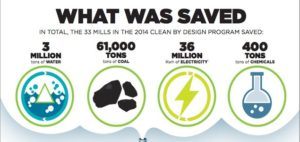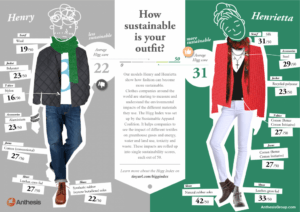Expect More, Waste Less – Target leads path toward responsible sourcing

Target maintains its Expect More, Pay Less promise while increasing responsibly sourcing through its supply chain
Producing one ton of fabric to make shorts and tees take 200 tons of water- the equivalent of multiple swimming pools [1].
For Target Corporation, whose 2015 annual sales reached $73.8B, roughly $14B coming from apparel and accessories, and approximately one-third of that related to their owned and exclusive brands [2], reducing Target’s environmental footprint can create meaningful change in an industry that contributes to a significant portion of the world’s water pollution and greenhouse gas (GHG) emissions [1].
The Basics: The Environment and Apparel Manufacturing
“The apparel industry is one of the largest polluters in the world. Textile mills generate one-fifth of the world’s industrial water pollution and use 20,000 chemicals to make clothes. In China, textile factories product about 3B tons of soot by burning coal for energy.” [1]. Coal is a primary source of GHG which is considered a leading cause of climate change [3].
In addition to the significant amount of GHG produced by textile factories, apparel manufacturing uses large quantities of water in its production processes. The water used gets flooded with chemicals and dyes from various processing steps. In countries with limited environmental laws, contaminated water is typically dispensed in the local water supply risking damage to agricultural yields of local farmers [1].
As the effects of climate changes continued to be surfaced, many members of the apparel industry, including Target, have taken strides to reduce the impact of their production processes to build a more sustainable business for the future. Although Target does not own or manage apparel factories, they can leverage their buying power to encourage their suppliers to become more environmentally responsible.
Getting Apparel Facilities on Track
Two ways Target is building a more sustainable and responsible supply chain is through their partnership with Clean by Design and their involvement with the Sustainable Apparel Coalition (SAC).
Clean by Design + Target
In 2012, Target began collaborating with the National Resource Defense Council (NRDC) on its Clean By Design initiative [4]. Clean by Design is a program created to encourage large organizations, like Target, to harness their buying power to reduce the negative impacts suppliers have on the environment. Not only does the program reduce the environmental impact of manufacturing practices, but it also improves operating costs for the mills and factories that implement changes [5].
Upon implementation, Target and others saw significant savings in water, energy, and materials. In 2015, the NRDC published savings of $14.7M for suppliers through the Clean by Design program [6].
In its 2015 annual report, Target reported a total reduction of water use of 726K tons. In its Social Responsibility Report, Target continues to track their Environmental goal to “Reduce GHG emissions: per % of retail sales.” Additionally, Target recently added, “engage additional vendors” with the Clean By Design program as a new long-term goal through 2020 [7].
Sustainable Apparel Coalition and Higg Index
The Sustainable Apparel Coalition (SAC) is an alliance established amongst industry peers and competitors whose efforts are focused on sustainable production. As one of the founding members [4], Target and the coalition created a standardized tool, the Higg Index, to measure the impact manufacturing processes have on the environment- example measurements include energy use and GTG emissions, water use, wastewater/effluent, emissions to air, and waste management. [8,9]
Figure 1. HIGG Index in use [10]
Looking ahead: What more can Target do?
While Target has made strides to create a more responsible and sustainable sourcing strategy, there are a few ways Target can continue to reduce their footprint and develop more robust energy conservation programs.
First, Target should consider incentivizing suppliers to improve support water management. Target can incentive suppliers by tying supplier performance to scores from the Higg Index, requiring factories to enroll in the Clean by Design model, or creating longer-term contracts with suppliers who invest in technologies that support water recycling. Second, Target should establish new environment goals to increase accountability to their responsible sourcing initiatives. For example, Target could add a new Environmental goal of “Reduce Water Use in our Supply Chain” with annual targets.
(637 words)
Sources:
[1] Sarah Murray, “Fixing the Fashion Industry,” January 5, 2016, https://www.nrdc.org/stories/fixing-fashion-industry, accessed November 2016.
[2] Target Corporation, 2015 Annual Report (Minneapolis: Target Corporation, 2016).
[3] Rebecca M. Henderson et al., “Climate change in 2016: Implications for Business” Harvard Business School case no. N2-317-032 (Harvard Business School, October 2016).
[4] “Responsible Sourcing.” Target Corporate. https://corporate.target.com/corporate-responsibility/responsible-sourcing, accessed November 2016.
[5] Linda Greer, “Clean by Design, Apparel Manufacturing and Pollution,” December 30, 2015, https://www.nrdc.org/resources/clean-design-apparel-manufacturing-and-pollution, accessed November 2016.
[6] Sustainable Brands, “#BusinessCase: Gap, H&M, Levi’s, Target Mills Save $14.7M Through NRDC’s Clean by Design Program,” April 16, 2015, http://www.sustainablebrands.com/news_and_views/chemistry_materials/sustainable_brands/businesscase_gap_hm_levis_target_mills_save_14. Accessed November 2016.
[7] Target Corporation, 2015 Corporate Social Responsibility Report (Minneapolis: Target Corporation, 2016).
[8] Sustainable Apparel Coalition, “The Coalition,” http://apparelcoalition.org/the-coalition/, accessed November 2016.
[9] Sustainable Apparel Coalition, “The Higg Index,” http://apparelcoalition.org/the-higg-index/, accessed November 2016.
[10] Data excerpted from “How sustainable is your outfit,” January 08, 2013, http://anthesisgroup.com/how-sustainable-is-your-outfit/, accessed November 2016





This was a great read and I didn’t realize how much emphasis Target put on its suppliers for apparel to be more sustainable. Another big piece of products is packaging and your article motivated me to find out what Target was doing to minimize product packaging as that is also a major source of waste. What I learned was that Target has improved the packaging on 153 of its own Brand packages. [1] Like you, I do agree that Target should do more. Along the same lines of your recommendation that Target push its suppliers to improve water management, I would argue that they should also push their suppliers to reduce the use of packaging material.
While not entirely sourcing related, I think another way Target can reduce its footprint is to have the right amount of product in the right place at the right time. That is to say, don’t overstock stores with apparel and clearance it out at the end of the season. If their sourcing can be more JIT, there’s opportunity for waste reduction in terms of reducing shipments needed and excess product created.
[1] https://corporate.target.com/_media/TargetCorp/csr/pdf/2015-Corporate-Social-Responsibility-Report.pdf#page=6
Definitely did not know that Target had such significant involvement in sustainability. I think you are spot on that Target, being the dominant player in the supply chain, needs to take the lead to influence the other stakeholders. Incentivizing suppliers in water and waste management would be great examples of how Target can scale up its impact. On the flip side, as a customer of Target, I do think that Target can use their brand to influence end users. I am assuming that many of the customers do not know that this is an initiative. Target could take a page from some other retailers’ books, such as H&M’s and introduce World Recycling Week – this could also generate additional goodwill for the company. Fixing the inefficiencies of the supply chain can only go so far, Target also needs to educate consumers on the demand side.